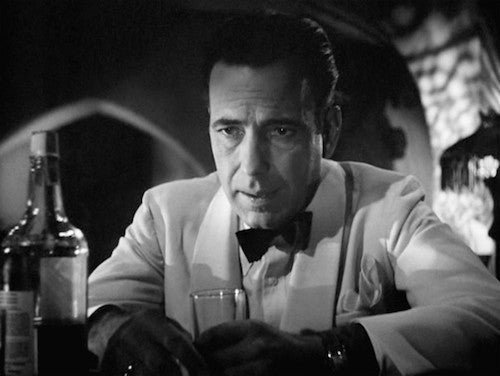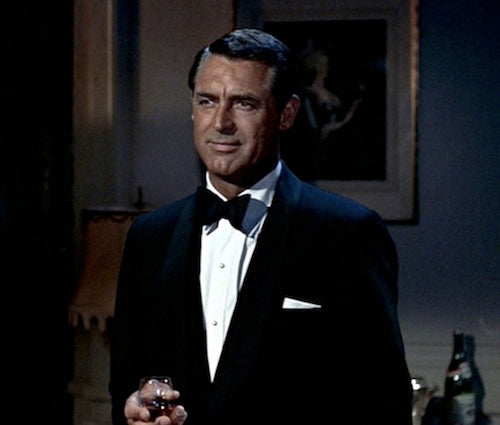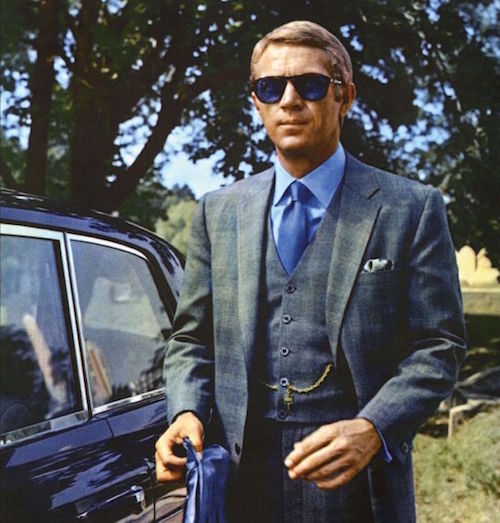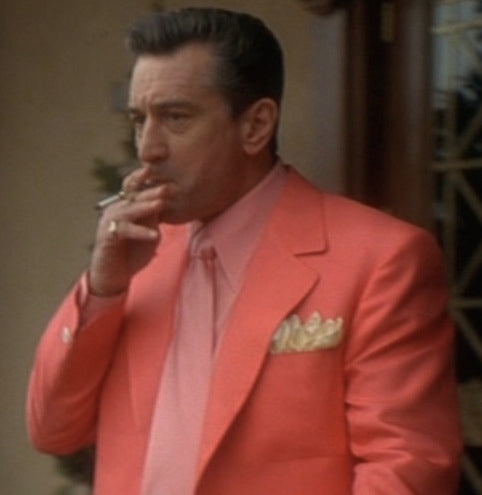Pocket Square Looks - A History In Cinema
In the blistering heat of Casablanca, Morocco set against a backdrop of impending terror, the humble white pocket square peeks through the left breast pocket of Humphrey Bogart’s white tuxedo, in the film set, and named after the infamous location. The film captures one of the greatest heartbreaks in cinema history, as we watch the detached and forlorn ‘gin joint’ owner, Rick Blaine come face to face with past love, Ilsa.

Appearing in a vast number of scenes throughout the film, the white pocket square acts as an anchor, constantly working to root Bogart’s emotions into a physical state. The unassuming white pocket square stands to contradict Bogart’s aloofness and detachment to his surroundings. In a series of flashbacks, we see Blaine, violently throwaway his beloved pocket square almost as if it were a white flag, surrendering his feelings to the disappearance of his lover as she fails to turn up to catch their train to a new life together.
Acting as a physical metaphor to the famed song, ‘As Time Goes By,’ the pocket square sits forever proudly in his breast pocket. Even when the film takes us back to earlier scenes between the lovers, Bogart’s pocket square remains white and linen throughout the film, a flashback to years earlier sees Bogart wearing a black tuxedo with a white pocket square planted in his breast pocket. Bow ties and patterned tie combinations all come into play throughout the film, however, the pocket square always remains white, firmly demonstrating the style credentials of the white pocket square and its true force as a style chameleon.
[ebook-signup]
We love how cinema has managed to capture the beauty and simplicity of pocket squares, and the elegance and sophistication they can bring to any outfit. Style icons such as Cary Grant and Clark Gable, capture the true glamour of Hollywood style in the 1940s and 50s with their ability to exude style and charm on and off screen. In To Catch A Thief, Grant styled his own wardrobe selecting casual pieces such as the infamous striped turtleneck and polka dot neckerchief as well as enduring classics such as the white pocket square and black tuxedo pairing.

As cinema skips forward the fashion of the 60’s transformed the unassuming white linen pocket square into a menswear fashion must-have and the film that defines style for many generations of men is The Thomas Crown Affair. What the film may lack in substance or story, Steve McQueen, who plays the suited up titular character, Thomas Crown never fails to impress with his pocket square and tie combos. Contrasting the romantic nature of Casablanca’s pocket squares, we are confronted with bolder colours, introduction of patterns and luxurious silk options.

The split screen storytelling give the film an edgy, urban feel, a nonchalant cool reflected in the style of Thomas Crown; his style successes become throwaway sartorial nods at how elegance and masculinity can go hand in hand.
As for more flamboyant characters in cinema, we think Robert De Niro as Sam ‘Ace’ Rothstein is the perfect example of 70’s and 80’s style where loud and patterned outfits were the height of fashion and no print or colour combination was frowned upon. We particularly love his brave style choices throughout his 52 outfit changes and how they become more bold and brash throughout the scenes. His salmon pink suit paired with a yellow pocket square stands out particularly in the film and we love how De Niro finishes the look off with a pair of pale pink socks.

For a more retrained and rather more subdued wardrobe, we look to the Far East where we see how costume has the charming ability to create an atmosphere and set a mood. In particular, the melancholic romance between two lovers, in “In The Mood For Love’ takes us on a journey, where Shanghai born director, Wong Kar-Wai manages to capture elegance in a simple 1960’s grey suit. Tony Leung’s character, Mr Chow shows us how to work the humble grey suit with a white pocket square, alongside an array of graphic print ties to contrast and also compliment the dazzling costume changes of his onscreen lover.
What can we learn about the pocket square in cinema?
1. White pocket squares are a style essential, wear cotton or linen for cool, casual occasions and dress up an outfit with silk pocket square to impress.
2. Matching ties, bow ties, and cravats with pocket squares is not advised. Instead choose an accessory that is several shades darker in tone than the pocket square you intend to wear. As advised by British fashion designer and official dress maker to the Queen, Hardy Amies; "To achieve the nonchalance which is absolutely necessary for a man, one article at least must not match."
3. If the suit is one colour, a patterned pocket square can be used to break up the monotony, adding eye-catching details can divert the eye to draw attention away from a large chest.
4. Vice versa if the suit is patterned, a simpler choice of pocket square is preferred as it will be less distracting so the whole outfit is viewed as a whole.

